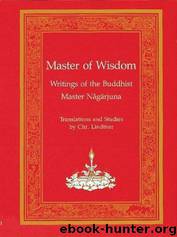Master of Wisdom: Writitngs of the Buddhist Mastar Nagarjuna by Christian Lindtner

Author:Christian Lindtner
Language: eng
Format: azw3
ISBN: 0898002869
Publisher: Dharma Publishing
Published: 1987-01-30T00:00:00+00:00
Sunyatasaptati
This text is in 73 verses (originally composed in the arya meter like the Vigrahavyavartani and the Pratityasamutpadahrdayakarika), accompanied by a commentary from the author's own hand (svavrtti). It is ascribed to Nagarjuna by Bhavya'79 Candrakirti,110 and Santaraksita.81 Testimonies anterior to these are found in the Akutobhaya82 and the *Dv5da§advaraka.83 Later on it is also referred to by Atisa.84 I have seen no references or allusions to the svavrtti, but as its prose style (in Tibetan, to be sure) is quite similar to the style of the commentaries on the Vigrahavyavartani and Vaidalyaprakarana, there is no good reason to impeach its authenticity. 115
The doctrine and scope of the Sunyatasaptati do not differ from those of the Mulamadhyamakakarika, to which it may be said to form an appendix,"6 as it partly summarizes its verses, partly introduces new topics and elaborates old ones. 117 Like the Mulamadhyamakakarika, it reveals no strict underlying structure of composition, but it may, as I have ventured, be divided into at least seven paragraphs.
For the study of the Sunyatasaptati I have had available several texts preserved in Tibetan, all of which are cited in the section on sources and variants in Part I.1`' The translations of the karikas included in the commentaries by Candrakirti and Parahita sometimes differ considerably - at times unhappily-from that given in Nagarjuna's svavrtti, and more often agree with the root text as it is found in the Tibetan Canon.89
As editions and translations of all the commentaries are expected, I have confined myself to an edition and translation of the root text. However, my translation of the karikas strictly follows the svavrtti, with only one or two exceptions, and should therfore be read in conjunction with the edition of the svavrtti given in Part II. Though I have consulted the commentaries of other authors, Nagarjuna's own remarks must of course remain the final authority in questions of interpretation.90
I present here the briefest possible summary of the text (based on the analysis given in the introduction to my Danish rendering of the verses with the svavrtti), followed by notes on the specific verses.
Download
This site does not store any files on its server. We only index and link to content provided by other sites. Please contact the content providers to delete copyright contents if any and email us, we'll remove relevant links or contents immediately.
| Acupuncture & Acupressure | Aromatherapy |
| Ayurveda | Chelation |
| Chinese Medicine | Energy Healing |
| Healing | Herbal Remedies |
| Holistic | Homeopathy |
| Hypnotherapy | Massage |
| Meditation | Naturopathy |
| Reference |
Inner Engineering: A Yogi's Guide to Joy by Sadhguru(6449)
The Power of Now: A Guide to Spiritual Enlightenment by Eckhart Tolle(5347)
Fear by Osho(4498)
Ikigai by Héctor García & Francesc Miralles(3903)
The Art of Happiness by The Dalai Lama(3851)
The Ultimate Bodybuilding Cookbook by Kendall Lou Schmidt(3713)
Yoga Therapy by Mark Stephens(3577)
The Little Book of Hygge by Meik Wiking(3451)
Why Buddhism is True by Robert Wright(3291)
The Healing Self by Deepak Chopra(3267)
Being Aware of Being Aware by Rupert Spira(3089)
The Hatha Yoga Pradipika (Translated) by Svatmarama(3081)
Shift into Freedom by Loch Kelly(3033)
Wild Words from Wild Women by Stephens Autumn(2941)
Work Clean by Dan Charnas(2904)
Happiness by Matthieu Ricard(2890)
More Language of Letting Go: 366 New Daily Meditations by Melody Beattie(2852)
Yoga Body & Mind Handbook by Jasmine Tarkeshi(2752)
Why I Am Not a Feminist by Jessa Crispin(2589)
